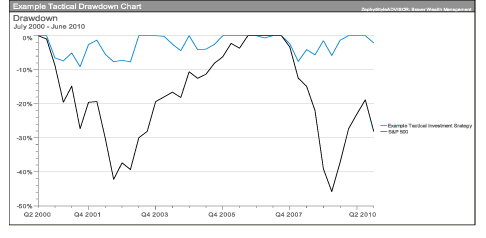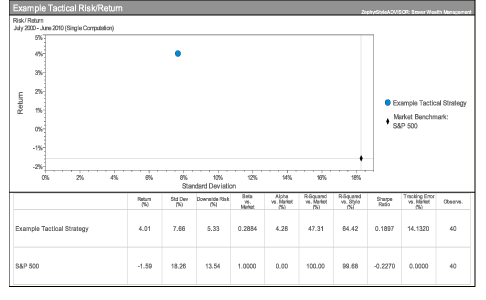Investing turmoil since 2008 has advisors' clients demanding answers and investment professionals searching for asset allocating strategies that will protect clients from future turbulence. Advisors today realize that the nature of investing has changed dramatically over the past ten to 20 years-but what is the real difference? Technological advances such as rapid trading programs, quantitative investment management, short sale trading and the growth of the short-term focused hedge fund business have all contributed to the challenges facing the long-term asset-allocation investing mindset. Momentum investment strategies that seek to capitalize on individual stock trends or sector trends now play a much larger role in the investment marketplace. Together, these factors have permanently increased volatility, cyclicality and trading volume.
Mainstream investment philosophy directs us to invest assets in the financial markets while mitigating risk through prudent diversification. Inherent in this approach is the belief that the best-performing asset class will vary from year to year and cannot be predicted. But what did we learn in 2008, a year when nearly all asset classes showed tremendous correlation on the downside? This approach does not work. Moreover, clients are tired of the roller coaster ride of investing and are demanding a more proactive approach with better wealth protection. Telling clients to "stay the course" isn't a solution.
Many studies have proven the importance of asset allocation decisions in meeting investors' financial objectives. The frequently referenced Brinson, Hood, and Beebower (BHB) research from 1986 analyzed asset allocation decisions and returns of 91 large pension funds. The study concluded that asset allocation decisions accounted for greater than 90% of the investment return and that active choices were less important, if needed at all. Many investment professionals continue to point to this study to prove that asset allocation is the most important investment decision and to support their buy and hold approach.
After the past decade of bubbles, followed by corrections, in technology, commodities, real estate, and most recently banking, investors are questioning the traditional asset-allocation, buy-and-hold approach. It simply has failed to produce consistent returns and diversification has not controlled downside risk. In fact, all major asset classes lost money in 2008 except for U.S. Treasury bonds. Correlation across all major asset classes was exceptionally high and this caused a huge loss of wealth around the globe.
Back in 1986, computers barely existed, nor did the "trading mentality" that technological advance has enabled. The BHB study likened active trading or management to 'market timing' but moving client assets out of the market when trends are severely negative is what is expected today of the smart investment advisor. Cash, or money market as a proxy for cash, is an important investment option when capital markets are declining.
The market's volatility of the past two years vastly increased investors' appetite for strategies that protect wealth in bear markets. So what's the solution for advisors and their frustrated clients? Rapid trading programs are not the answer as these are difficult to implement in an individual client portfolio and they tend to be extremely tax inefficient. The answer lies with tactical investment strategies, which are emerging as a viable option for risk control in a prudently diversified total portfolio.
Tactical strategies seek to allocate the portfolio to the asset classes that are most attractive at a given time, and tactical, short-term adjustments are made to take advantage of market trends. Cash is a viable investment option in many of these investment strategies and facilitates wealth preservation and downside risk mitigation.
Many advisors have been slow to adapt this tactical investing approach because they have been trained to believe that market timing does not work. To change this mindset, advisors need to view these tactical investment strategies not as market timing but as proactive and systematic buy and sell disciplines made possible due to the major technological advancements over the past 20 years. Active investment strategies that tactically allocate assets to areas of the markets that are trending well (including cash) while avoiding declining areas is a sophisticated quantitative investment solution.
Today, tactical strategies utilizing quantitative computer models are more of a science and less of an art. These are data-driven strategies whereby computer models analyze asset class trends and momentum factors to determine where to invest. In broadly declining markets, these computer models are built to stop losses as soon as a downtrend is confirmed and reinvest in a stable asset class or cash to protect wealth. These are not emotional decisions but rather systematic buy-and-sell disciplines based on a wide array of technical and momentum factors. If no asset class or market segment under consideration is exhibiting stable or positive trends, the strategies often default to cash until trends stabilize and improve. In today's volatile world, investors realize that it is more important to avoid major down-market corrections than it is to capture every up day.
While traditional asset allocation investment decisions largely depend on expectations of macro-economic outcomes, future earnings growth and future valuation levels, tactical decisions are not based on future events-rather decisions are based on current market trends. If one believes that market timing is difficult, predicting the future is even more difficult! Broadly diversifying across investment philosophies further mitigates total portfolio risk. Below is an example drawdown chart of a tactical investment strategy compared to the broad market benchmarks.


As the second chart illustrates, over a 10-year period from July 2000 to June 2010, this strategy has outperformed the S&P 500 by 560 bp with respectively a standard deviation and downside variance of only 42% and 39% of the S&P 500's.
Advisors can consider active, tactical investing as a permanent component of a well-diversified total portfolio by segregating 20-30% of a client's portfolio to invest in tactical strategies available from Separate Account Managers or through pooled vehicles. Advisors need to do due diligence and seek managers with real long term track records, proven tactical formulas, strong reputations and competitive fees.
Advisors should be careful reviewing a manager's hypothetical back-tested results and should instead seek actual GIPS compliant historical figures. Investment strategies that can employ a high level of cash add true differentiation, downside protection and wealth preservation. Clients will appreciate the proactive nature of tactical management, especially in down-trending markets.
No one investment strategy works in all market environments. But the next time there is a large market decline and your client's portfolio holds a large defensive cash position, you will have something positive to say beyond just "stay the course."
David J. D'Amico, CFA, is president of Braver Wealth Management LLC (thebravergroup.com/wealth-management).








